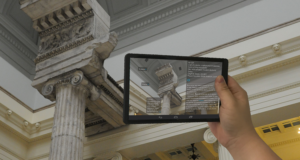Architecture comes alive through Carnegie Museum of Art’s new Plaster ReCast augmented reality app

At Carnegie Museum of Art, it’s serene in the Hall of Architecture as impressive plaster casts of giant, structural wonders loom all around. It’s easy to get lost in the 150 building facades, monuments and fragments from across the Western world. But admiring the details of a solitary column begs the question of how it looked as part of a bygone edifice.
With a Google Tango tablet in hand, Josh Bard, an assistant professor at the Carnegie Mellon University School of Architecture, points at the column and taps a button. On the screen, a 3D animation of the Tomb of Mausolus in Turkey, a historical site built circa 350 BC, takes shape. It’s surrounded by columns on all sides.
The tablet is outfitted with Plaster ReCast, a new augmented reality app soon to become available to the public for playtesting. Created by CMU’s Entertainment Technology Center under the supervision of Bard and fellow architecture professor Dr. Francesca Torello, the technology is designed to help visitors better engage with the CMOA’s plaster cast collection.
Established in 1907 by the museum’s founder, steel magnate Andrew Carnegie, the Hall houses the third largest architectural cast collection in the world, right behind those at the Victoria and Albert Museum in London and the Cité de l’Architecture in Paris. While the Hall and its collections are rich with history, including fantastic origin stories (one piece was part of a mysterious giant water clock that confounded experts for years), much of that gets lost in the museum’s efforts to retain its beauty.
The app allows guests to explore the Hall while learning about several select pieces. Three interaction modes allow you to more closely investigate 3D scans of the casts, pull up detailed models of the building to which it once belonged, and read about a cast’s history, complete with scans of old documents and images.
“Museums, in general, are still grappling with how much technology to provide in galleries,” says Skjeie, pointing out that visitors are already distracted enough by their own smartphones. “We’re very curious to see how visitors react to it.”
See the full story here: https://www.nextpittsburgh.com/latest-news/architecture-comes-alive-through-carnegie-museum-of-arts-new-plaster-recast-augmented-reality-app/
Pages
- About Philip Lelyveld
- Mark and Addie Lelyveld Biographies
- Presentations and articles
- Tufts Alumni Bio